Book contents
- Half title page
- Cambridge Studies in International and Comparative Law
- Title page
- Copyright page
- Dedication
- Dedication
- Contents
- Book part
- Table of treaties
- Table of cases
- 1 Introduction
- Part I The legal framework for the governance of natural resources in States
- Part II The governance of natural wealth and resources in situations of armed conflict
- Part III The governance of natural resources as part of conflict resolution and post-conflict peacebuilding efforts
- Bibliography
- United Nations Documents
- Index
- Cambridge Studies in International and Comparative Law
- References
Bibliography
Published online by Cambridge University Press: 05 July 2015
- Half title page
- Cambridge Studies in International and Comparative Law
- Title page
- Copyright page
- Dedication
- Dedication
- Contents
- Book part
- Table of treaties
- Table of cases
- 1 Introduction
- Part I The legal framework for the governance of natural resources in States
- Part II The governance of natural wealth and resources in situations of armed conflict
- Part III The governance of natural resources as part of conflict resolution and post-conflict peacebuilding efforts
- Bibliography
- United Nations Documents
- Index
- Cambridge Studies in International and Comparative Law
- References
Summary

- Type
- Chapter
- Information
- International Law and Governance of Natural Resources in Conflict and Post-Conflict Situations , pp. 432 - 454Publisher: Cambridge University PressPrint publication year: 2015



